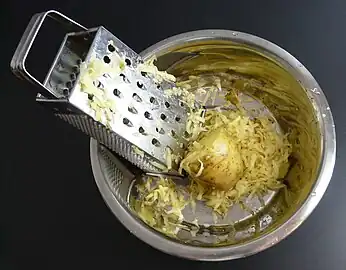 A plate of rösti with a parsley garnish | |
| Type | Side dish |
|---|---|
| Place of origin | Switzerland |
| Region or state | Canton of Bern |
| Main ingredients | Potatoes, butter or other fat |
Rösti or rööschti (Alemannic German: [ˈrøːʃti]) is a Swiss dish consisting mainly of potatoes, sautéed or shallow-fried in a pan. It was originally a breakfast dish, commonly eaten by farmers in the canton of Bern, but is now eaten all over Switzerland and around the world. The French name röstis bernois directly refers to the dish's origins.
Many Swiss people consider rösti to be a national dish.[1] Rather than considering it a complete breakfast, lunch or dinner, it is more commonly served to accompany other dishes such as Spinat und Spiegelei (spinach and fried eggs, sunny side up), cervelas or Fleischkäse. It is commonly available in Swiss restaurants, as a replacement for the standard side dish of a given meal.
Preparation
Rösti dishes are made with coarsely grated potato, either parboiled or raw.[1] Rösti are most often pan-fried and shaped in the frying pan during cooking, but they can also be baked in the oven. Depending on the frying technique, oil, butter, cheese, or another fat may be added (and usually salt and pepper). The grated potatoes are shaped into rounds or patties, usually measuring between 3 and 12 cm (1 and 5 in) in diameter and 1 and 2 cm (0.4 and 0.8 in) thick.
Although basic rösti consists of nothing but potato, a number of additional ingredients are sometimes added, such as bacon, onion, cheese, apple or fresh herbs. This is usually considered to be a regional touch.
In Palau, instead of potato, rösti is prepared from the grated corm of taro.
- Cooking rösti
 Grating potatoes
Grating potatoes Cooking
Cooking Cooking
Cooking Pan makes it round
Pan makes it round
Cultural impact
In Swiss popular cultural ethos, rösti are predominantly eaten in German-speaking regions, although they can be found easily elsewhere in the country. Rösti dishes are portrayed as a stereotypical part of the Swiss-Germanic culture, as opposed to Latin culture. The geographic border separating the French and German-speaking parts of the country is therefore commonly referred to as the Röstigraben: literally the "rösti ditch".
Classic rösti dishes
- Dishes
 Rösti topped with eggs
Rösti topped with eggs Rösti with veal sausage and onion sauce[2]
Rösti with veal sausage and onion sauce[2] Rösti with Zürcher Geschnetzeltes
Rösti with Zürcher Geschnetzeltes
See also
- Latke
- Hash browns, a similar American dish
- Maluns, a fried potato dish eaten in the Grisons canton of Switzerland
- Potato pancake
- List of potato dishes
- Liechtenstein cuisine
References
- 1 2 Cloake, Felicity (13 October 2011). "How to cook the perfect rösti". The Guardian. Retrieved 19 July 2016.
- ↑ "Saucisse de Saint-Gall: régal de bout en bout". Betty Bossi. Retrieved 9 January 2023.
Sauces et moutarde auraient simplement pour effet de masquer le goût subtilement épicé de la saucisse. Seule exception autorisée: la sauce aux oignons lorsque la Saint-Galloise est escortée de rösti.
[Sauces and mustard would simply mask the subtly spicy taste of the sausage. Only exception allowed: the onion sauce when the St-Galler is accompanied by rösti.]